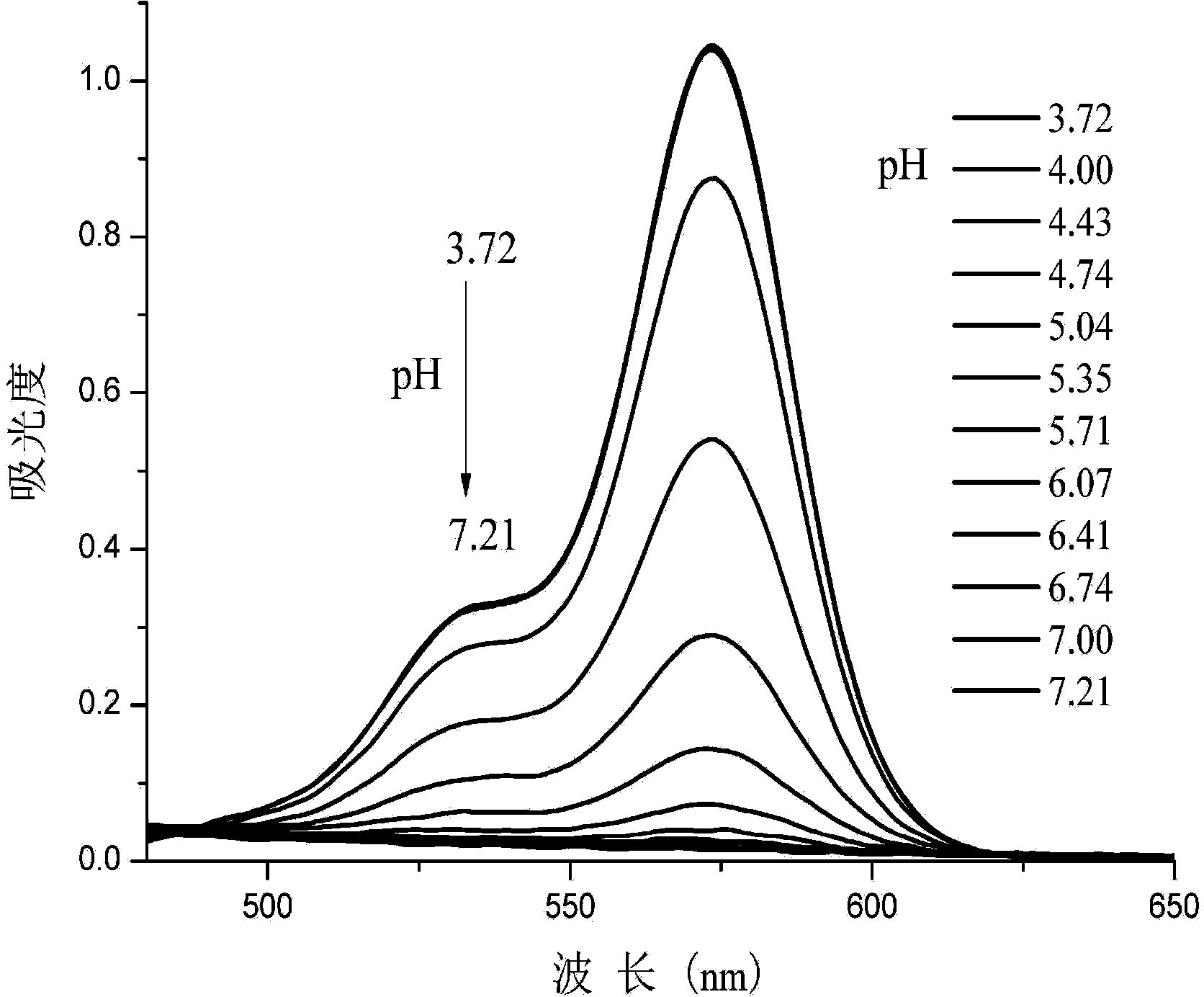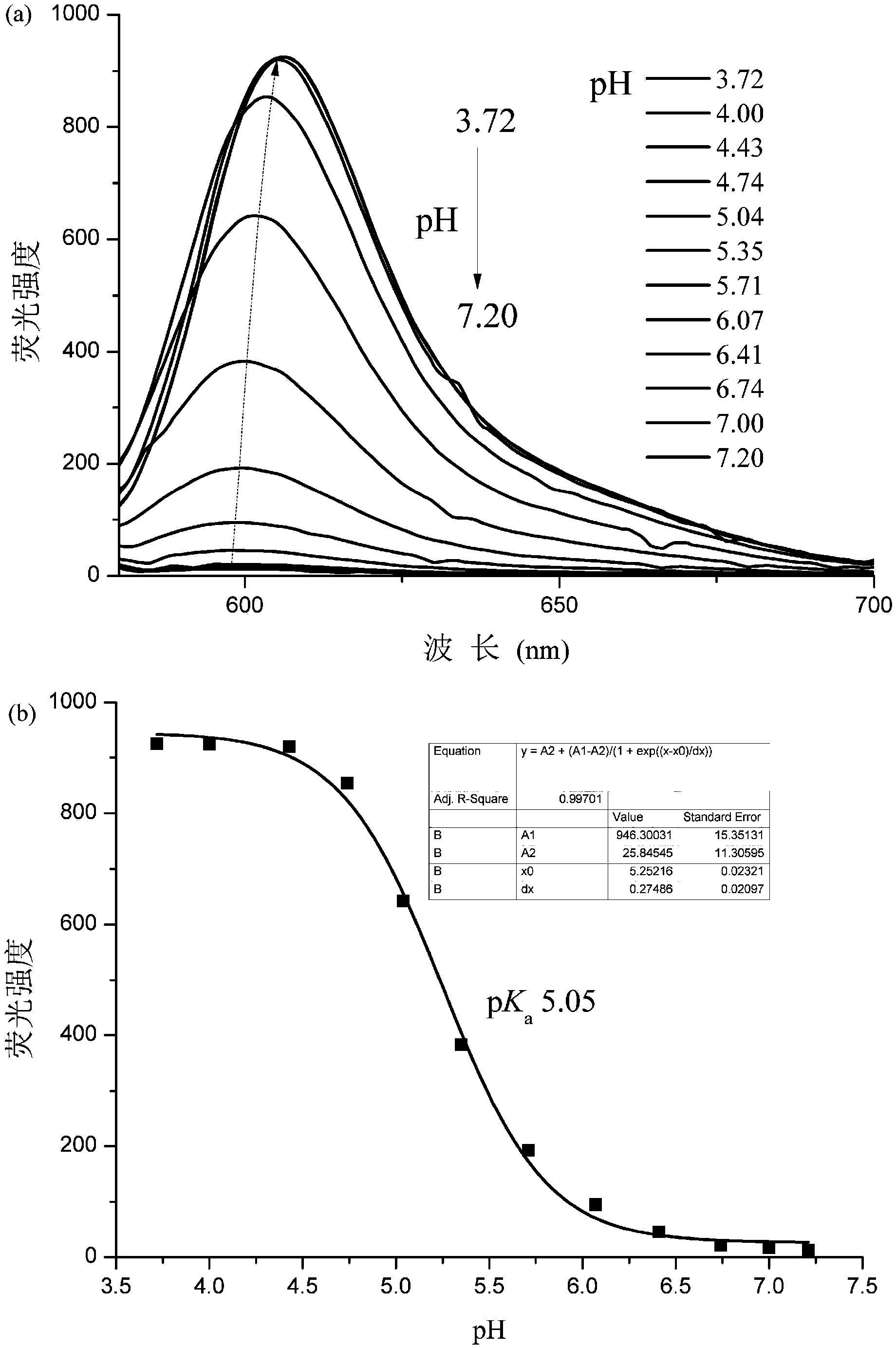1,3,4-oxadizaole structure unit-containing rhodamine b ph fluorescence probe and applications thereof
A technology of structural units and fluorescent probes, applied in the fields of fluorescence/phosphorescence, luminescent materials, organic chemistry, etc., can solve the problems of affecting the monitoring results and increasing the pH value of lysosomes, and achieve good anti-interference ability, rapid response, high Effects of Sensitivity and Selectivity
- Summary
- Abstract
- Description
- Claims
- Application Information
AI Technical Summary
Problems solved by technology
Method used
Image
Examples
Embodiment 1
[0032] Synthesis of Rhodamine B pH Fluorescent Probes Containing 1,3,4-Oxadiazole Structural Units
[0033] 320 mg (0.5 mmol) of compound 1 and 80 mg (0.5 mmol) of compound 2 were dissolved in 10 mL of dry acetonitrile, 104 mg (0.75 mmol) of potassium carbonate was added, and the mixture was heated to reflux and reacted for 2 hours. After cooling, potassium carbonate was filtered off, and the filtrate was concentrated under reduced pressure to obtain a crude product. Purified by silica gel column chromatography (2:1, petroleum ether-ethyl acetate) to obtain 265 mg of light yellow compound 3, which is a rhodamine B-type pH fluorescent probe containing 1,3,4-oxadiazole structural units, the yield : 82.7%, melting point: 133-135°C.
[0034] Above-mentioned synthetic route reaction formula is as follows
[0035]
[0036] Infrared spectrum measurement: IR (KBr) ν: 3406 (N-H), 1615 (C=O) cm -1 .
[0037] H NMR spectrum determination: 1 HNMR(d 6 -DMSO,400MHz))δ(ppm):1.10(t,1...
Embodiment 2
[0040] Prepare 10 mL of the probe 3 (10 μM) solution (ethanol / Britton-Robinson buffer solution, 40 mM acetic acid, phosphoric acid, boric acid, 1:9, volume ratio, 0.1 M NaCl) under the gradient pH value (3.72-7.21), respectively. Perform UV-visible spectrophotometry and fluorescence spectrophotometry tests, and make a curve of the fluorescence intensity at 603nm as a function of the pH value.
[0041] The results showed that probe 3 had a good response to the pH value. After the pH value changed from 6.7 to 4.4, its fluorescence intensity was increased by about 46 times, which had a good fluorescence enhancement effect and could improve the sensitivity and accuracy of the signal. ( figure 2 , 3 )
Embodiment 3
[0043] After adding various metal ions to the solution of probe 3 (10 μM) with a pH value of 4.74 (ethanol / Britton-Robinson buffer solution, 40 mM acetic acid, phosphoric acid, boric acid, 1:9, volume ratio, 0.1M NaCl), Test its fluorescence intensity change. (excitation wavelength (λ ex ), 565nm; Al 3+ ,Cu 2+ ,Fe 3+ ,Zn 2+ ,Cd 2+ ,Hg 2+ , Ni 2+ ,Co 2+ ,Pb 2+ , Ag + The concentration is 200μM, Na + and K + Both are 10mM, Ca 2+ and Mg 2+ Both are 5mM)
[0044] After adding various metal ions to the solution of probe 3 (10 μM) with a pH value of 7.21 (ethanol / Britton-Robinson buffer solution, 40 mM acetic acid, phosphoric acid, boric acid, 1:9, volume ratio, 0.1M NaCl), Test its fluorescence intensity change. (excitation wavelength (λ ex ), 565nm; Al 3+ ,Cu 2+ ,Fe 3+ ,Zn 2+ ,Cd 2+ ,Hg 2+ , Ni 2+ ,Co 2+ ,Pb 2+ , Ag + The concentration is 200μM, Na + and K + Both are 10mM, Ca 2+ and Mg 2+ Both are 5mM)
[0045] The results show that the response of ...
PUM
| Property | Measurement | Unit |
|---|---|---|
| melting point | aaaaa | aaaaa |
Abstract
Description
Claims
Application Information
 Login to View More
Login to View More - R&D
- Intellectual Property
- Life Sciences
- Materials
- Tech Scout
- Unparalleled Data Quality
- Higher Quality Content
- 60% Fewer Hallucinations
Browse by: Latest US Patents, China's latest patents, Technical Efficacy Thesaurus, Application Domain, Technology Topic, Popular Technical Reports.
© 2025 PatSnap. All rights reserved.Legal|Privacy policy|Modern Slavery Act Transparency Statement|Sitemap|About US| Contact US: help@patsnap.com



